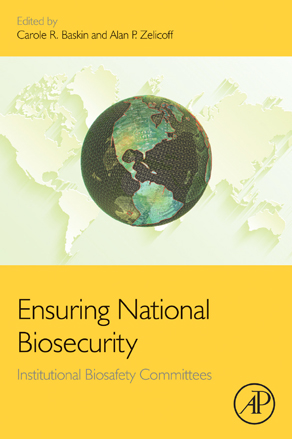Author: Carole Baskin and Alan Zelicoff
ISBN No: 9780128018859
Review date: 19/04/2024
No of pages: 258
Publisher: Butterworth-Heinemann (Elsevier)
Publisher URL:
http://store.elsevier.com/Ensuring-National-Biosecurity/isbn-9780128018859/
Year of publication: 09/08/2016
Brief:
Ensuring National Biosecurity: Institutional Biosafety Committees by Carole Baskin and Alan Zelicoff
Research into the bio-sciences or life sciences could bring breakthroughs for the good of mankind – or it could deliver deadly weapons to terrorists. Or indeed both. Or, lax safety and site security could mean that some plague deadly to animals and humans and maybe the whole planet is let loose. Remember the attention that the Ebola virus got after outbreaks in West Africa in 2014 – and indeed Ebola is ‘the subject of much biomedical research’.
The scientists in the field well understand this, as shown in a book, Ensuring National Biosecurity: Institutional Biosafety Committees brought together by Carole Baskin and Alan Zelicoff. As so often with American books, when the title says ‘national’ it means the United States.
Scientists are not the only ones with interests in the biosciences; policy-makers too decide which research to fund, and to maybe disallow; university or lab administrators make the work possible, as do security professionals. Early on the book – made by more than 20 contributors – makes the point: “Without adequate bio-containment facilities, laboratory and vivarium rooms, suites, and buildings, there cannot be adequate control of biohazards, particularly with respect to protection of individuals outside the laboratory.”
The book goes through the regulations and origins of bio-security, which includes much that is familiar to the security person, such as access control (though here it’s toxins that you are trying to keep in) and risk assessment, staff screening and emergency planning. Biosafety – once you define it, such as safe handling and containment of those biological agents – also becomes familiar to security people as it can becoming one of ‘competing priorities and pressures’ – yes, scientists want to be safe, but they also want to get on with the job without the ‘burden’ of filling in review forms and hassle generally (as they may see it) of oversight. If you don’t know a pathogen from a toxin, and you work for a university that may well do experiments, you may well need to understand more, so as to have more credibility with the non-security people you deal with and after all are working for. The book argues for a friendly approach between overseers and researchers: “A common dilemma faced at many academic institutions is a feeling that researchers are “policed” rather than treated as collaborators.” In practice, this means an ‘open door’ approach – but hopefully that open door does not let infectious disease out!? In labs as in other workplaces, such as aviation and the railways, it seems that scrupulous and good safety and security go together, and likewise if they are bad.
While this book does go into detail, it’s detail of the American experience – the rules, the organisations. But as the book does say, it is ‘incumbent upon biological scientists, research administrators,
security experts, and policy-makers to cooperate’, to minimise risk. While we might think of biological sciences in terms of animals, and experiments – mice are surprisingly similar to humans in terms of genetics and anatomy apparently – bioscience takes in crops also. Here we’re talking about GM (genetically modified) food, again with high stakes for humanity.
To sum up then, you might not except in this book ever come across mouse pox – and if security is done right, with simple things as locks and keys and inventories, and what the book calls ‘a good safety and security culture’, we can keep it that way.









